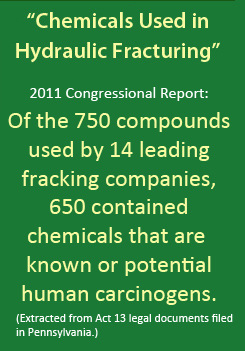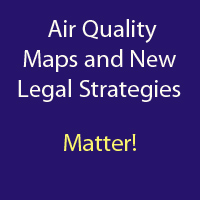New York Times publishes study and documents: Natural Gas’s Toxic Waste
EXCERPT: “Over the past nine months, The Times reviewed more than 30,000 pages of documents obtained through open records requests of state and federal agencies and by visiting various regional offices that oversee drilling in Pennsylvania. Some of the documents were leaked by state or federal officials. Here, the most significant documents are made available with annotations from The Times.
This study was provided to The Times by an E.P.A. official who said it shows that dilution of drilling waste does not always succeed in eliminating the health risks posed by that waste. The study is marked confidential and was conducted on behalf of the American Petroleum Institute in 1990. It found a potential increased risk of cancer among people who often eat fish from waters where drilling waste is discharged. The study is relevant because state regulators in Pennsylvania have said that dilution is effectively removing the risks posed by drilling waste that is discharged into rivers. Importantly, this study found an increased risk of cancer when drilling waste was dumped into a larger body of water than Pennsylvania rivers. Furthermore, state records indicate that the radium levels found in Pennsylvania wastewater are much higher than those used in this study. Radium, for example, was found in Pennsylvania at levels over 18 times the number used in the this study. It should be noted, however, that this study did not detail actual cases of increased cancer. Rather, it modeled potential increases in cancer rates as a result of radium-laced drilling waste being discharged into large waterways.
In an e-mail exchange with The Times, Anne F. Meinhold, one of the lead authors of of the study, wrote, “I suspect that the dilution rates in a river would not be as high as for the open water discharges we considered.” She cautioned, however: “The bioaccumulation factors and ingestion rates we used were based on data collected in the Gulf of Mexico. I don’t know if bioaccumulation factors for freshwater fish would be similar or if freshwater fishermen could be assumed to eat as much fish caught over their lifetime.”
Asked about the study, Bill Bush, a spokesman for the American Petroluem Institute, said, “We have no reason to challenge what’s in the study, but to confirm it’s accurate would require someone with expertise to go over it and thoroughly digest what it says in light of any additional related research done over the past 20 years.” Asked to review the study, an expert on human health and ecological risk analysis said that it clearly shows that the drilling waste is not sufficiently diluted in some cases. As a result, the radioactivity levels left behind in receiving waters come close to reaching the threshold at which the E.P.A., under federal Superfund rules, requires a cleanup, the risk expert said.”







